CALAX opens way for Silang, Cavite’s cityhood
By Roderick L. Abad ContributorONGOING infrastructure developments have constantly brought changes and paved the way for economic progress in the country, particularly in rural areas where public works and highways are highly needed to help fast track recovery from the ensuing health crisis.
With the imminent postCovid era amid the improving pandemic situation nationwide at present, big-ticket initiatives like the Cavite-Laguna Express way (CALAX) are pivotal to con tinuously transform and drive the growth of its covered localities and nearby places given the re laxed mobility restrictions and re sumption of trade and commerce after more than two years that most parts, if not the entire Phil ippines, have been locked down.
Th is P35.7-billion expressway is a public-private partnership (PPP) project of the Department of Public Works and Highways (DPWH) and MPCALA Holdings Inc. (MHI), a subsidiary of Metro Pacific Tollways Corp. (MPTC), the toll road development arm of Metro Pacific Investments Corp. (MPIC).
Forming part of the “Build, Build, Build” program of the pre vious administration, this 45-ki lometer controlled-access tollway has been partially operational since July 2019.

The opening of CALAX has been a big help to us,” Silang, Cavite Mayor Kevin Anarna told report ers in mixed Filipino and English during an interview at his office in their newly built Municipal Hall in Barangay Biga on Wednesday, No vember 23, 2022.

A mong the benefits their firstclass municipality has gained from it are efficient transport facilities,
traffic decongestion, and increased competitiveness, which are very crucial for its continued develop ment and cityhood by 2025, ac cording to him.
Reduced traffic congestion
THOUSANDS of motorists going to and from south of Luzon via
CALAX daily experience a con sistently smooth commute, with

more standing to benefit once the soon-to-open Silang (Aguinaldo) Interchange becomes operational.
Th is fifth of the eight segments of the tolled highway spans 3.9 km, with a 2x2-lane expressway from Silang East Interchange to Agui naldo Highway in Cavite. Upon completion, this will serve more motorists, including the 298,000 Silangeños, given the reduced traf fic situation.

Cu rrent average daily traffic is 33,000 from Mamplasan to Silang Ease interchange. This is expected to increase to 40,000 when the Silang (Aguinaldo) Interchange finally opens, thus, easing the usual bottleneck along the 41-km Aguinaldo Highway—the busiest main thoroughfare in Cavite—not to mention Governor’s Drive and Santa Rosa-Tagaytay Road.
With construction works now under way, the local chief executive admitted that traffic in their area is heavy, especially on weekends.
As of now, we don’t allow sixwheeler trucks that make our town as a pass road going to Tagaytay, Amadeo or Alfonso,” he said, while specifically citing the communities of Maguyam, Kaong and Tibig as shortcut routes.
“Due to different constructions, we closed them for the meantime for six-wheeler trucks and up to help lessen the volume of traffic.”
Hopeful of its rapid comple tion, Anarna sees that the inter change will ease the traffic, there by encouraging more people not only to pass by their municipality to neighboring towns and cities, but also to visit and see its natural wonders, tourist spots and other attractions.
Fast transport of goods SPANNING at 15,641 hectares, Silang is Cavite’s second largest lo cality. With more than half or 60 percent of its land area being ar able, its economy still depends on agriculture.

A mong its local produce, cof fee remains to be a top agricultural product—thanks largely to its el evation of more than 1,000 feet

The birth of a new city-in-the-making
Continued from A1
above sea level conducive to grow ing robusta and excelsa beans.
G ourmet Farms, the coun try’s largest trader of coffee, keeps on operating here. Over time, however, Anarna, whose family used to own the largest coffee mill in Silang, revealed that the number of local coffee farmers has diminished.
Nevertheless, many are ven turing to planting agar wood. Its branch, known for its fragrant scent, is used as a raw material for perfumes. Because its tree could be sold at around half-a-million pesos, most of his constituents are now growing this plant, he said.
“ With CALAX, these and our other goods are now easily trans ported to Metro Manila and other areas,” the mayor said.
Investment boom EVEN before the pandemic, there’s no stopping Silang from becom ing an emerging hub for various industries and businesses, such as manufacturing, real estate, travel and leisure, to name a few.
In fact, it is home to light in dustrial parks, with the existing one along Maguyam town road, and soon in Sabutan area (10 hect ares) and East-West Road (18 hect ares). Per the local chief executive, business locators, mostly manufac turing companies, are starting to invest in the upcoming processing zones.
He said “since the opening of CALAX, potential investors are coming in.”
Other entities have also en tered Silang, notably, Alfamart, which opened its largest distri bution center in the country six months ago. Currently, logistics company DHL is also applying to set up its facility here.
Adding to the Villar familyowned AllHome Premier, major re tail and mall operators are setting up their businesses in this part of Cavite.
L ocal residents will see the rise of Walter Mart next year. The Syled SM group plans to acquire an 8-hectare land near the Silang exit to put up a mall.
“Apart from businesses brought in by our new roads, in frastructure [projects like CALAX also] generate jobs. Also, they cre ate buying power for our constitu ents. Because of their patronage, even small businesses like sarisari stores make profits. So there’s a domino effect. In return, the economy revolves, generating ad ditional income and employment,” Anarna explained.
A s Silang becomes more at tractive to businesses due to such public works, it also has captured the interest of potential investors in real estate as property values there have begun to appreciate.
For instance, the mayor not ed that in Westgrove, the price of land has almost quadrupled from P13,000 per square meter in 2017 to P50,000 per sqm at present. At Riviera Golf Course near the Agui naldo Exit, on the other hand, the cost of shares has increased seven fold from P100,000 apiece in 2020 to P750,000 each today.
Because of this, key real-estate players have also penetrated this market, with Cathay Land being heavily invested here with 1,300 hectares for its development proj ects, as well as Ayala Land.
Economic growth driver, cityhood-enabler
THE influx of businesses, appar ently due to strategic develop ments of Silang with the CALAX project, has bolstered its economy.
On average, the municipality’s annual revenue is pegged at around P300 million. With the new admin istration, under the leadership of Anarna, it has already generated more than half of yearly overall taxes it regular makes.
“Compared to last September, our revenue collection is more than P200 million already. We can really
do P500 million,” the mayor said. “But I told our department heads, we can hit our target of P600 mil lion by end of this year since we are now business-friendly.”
Confident to achieve their 2022 revenue target, he is certain to also realize their dream to be come a full-fledged city since they have not failed to surpass the P200 million annual average income re quirement for such status, not to mention the other metrics, includ ing the population and land area.

The province has a plan for such goal for Silang, with support from Governor Jonvic Remulla, who is certain on its realization in the next three to six years.
“Even before the opening of CALAX, we are already qualified for cityhood. But still, it will be a big factor once the CALAX is fully operational because our economy will grow. So we will have more ad vantage to become a city,” Anarna pointed out.
On ROW issue
CALAX is a work in progress. At present, its operational segment spans 14.24 kilometers with inter changes at Greenfield-Mamplasan, Laguna Technopark, Laguna Bou levard, Santa Rosa-Tagaytay, and Silang East. Other interchanges, namely, Open Canal, Governor’s Drive and Kawit, are targeted to be completed by 2023.
Upon completion of its entire ty, it will connect to the ManilaCavite Expressway (Cavitex) in Kawit, Cavite.
Given the manifold gains this project has for their munici pality, he expressed support to MHI’s initiative, while urging the DPWH and private land own ers to address the right-of-way (ROW) issue hounding the Silang (Aguinaldo) Interchange to speed up its completion.
The target opening date of this subsection of the highway has been moved several times, with the lat est target completion—December of 2022—again uncertain.
The undelivered ROW of about 450 meters of land owned by a private corporation prevents the progress of continuous works, in cluding construction of drainage and bridge, excavation and road way earthworks, and installation of fence and coco net. To date, 64 percent of this segment has been completed.
“ We are very willing to help
MPCALA and the national gov ernment to fast-track the opening of the CALAX Silang (Aguinaldo) Interchange,” the local chief execu tive assured.
Upon learning that it built horseracing structures on the prop erty sans the necessary permits from the government, the munici pality’s inspection team deployed there several times to check the area. They even got the necessary requirements for the landowner that is hampering its completion.
“ We informed them that other payments are under-valued. So we check what legal remedies we can do,” Anarna said, adding that prior to giving “legal pressure,” they met and brought the owner to beautiful spots and restaurants in Silang to show what the local government is losing in terms of tourism.
“Our sceneries are beautiful, and also the tourist attractions. Because that portion is unfinished yet due to right-of-way concerns, they are not being developed and visited well. Beyond that, our de velopment is hampered due to rough inner roads, which can only be repaired once the Aguinaldo exit is done,” he added.

The local government unit is now planning to set up another meeting with the owner of the land to discuss the ROW issues. The mayor said, “Maybe, we can get a compromise agreement before the end of the year.”
Such is very important to ex pedite the project’s completion, hopefully, in the first quarter of 2023, in preparation for the up coming two international horticul ture events to be hosted by Silang in January and April next year.
We want to be known as the ‘Botanical Garden of the Philip pines,’” Anarna stressed, while expressing confidence of attaining this goal with further develop ments in the pipeline.
For 2023, Silang’s budget is P1.4 billion, up P200 million from P1.2 billion this year. From next year’s appropriation, P60 million is allotted for road repairs. The LGU, likewise, requested another P100 million from the national govern ment for such undertakings.
Complementing these will be the expansion of roads, particular ly those near the exits, by at least six meters.
Copper’s biggest mystery seen finally cracking
By Thomas BiesheuvelTHE warnings keep getting louder: the world is hurtling toward a desperate shortage of copper. Humans are more dependent than ever on a metal we’ve used for 10,000 years; new deposits are dry ing up, and the type of breakthrough technologies that transformed other commodities have failed to materi alize for copper. Until now.
In what could prove a game changer for global supply, a US startup says it’s solved a puzzle that has frustrated the mining world for decades. If success ful, the discovery by Jetti Resources could unlock millions of tons of new copper to feed power grids, building sites and car fleets around the globe, narrowing and possibly even closing the deficit.
At its simplest, Jetti’s technology is focused on a common type of ore that traps copper behind a thin film, making it too costly and difficult to extract. The result is that vast quanti ties of metal have been left stranded over the decades in mine-waste piles on the surface, as well as in untapped deposits. To crack the code, Jetti has developed a specialized catalyst to disrupt the layer, allowing rock-eating microbes to go to work at releasing the trapped copper.
The technology still needs to be proven on a large scale. But the riches at stake are pulling in some of the in
dustry’s most powerful players.
BHP Group, the biggest mining company, is already an investor and has now spent months negotiating for a trial plant at its crown jewel copper mine, Escondida in Chile, according to people familiar with the matter. US miner Freeport-McMoRan Inc. began implementing Jetti’s technology at an Arizona mine this year, while ri val Rio Tinto Group is planning to roll out a competing but similar process.
The miners are responding to an increasingly urgent problem. Copper is ubiquitous in the modern world, used in everything from phones and comput ers to water pipes and cables. And while the global drive to decarbonize is based on phasing out dirty natural resources like oil and coal, an electrified future will need more copper than ever before.
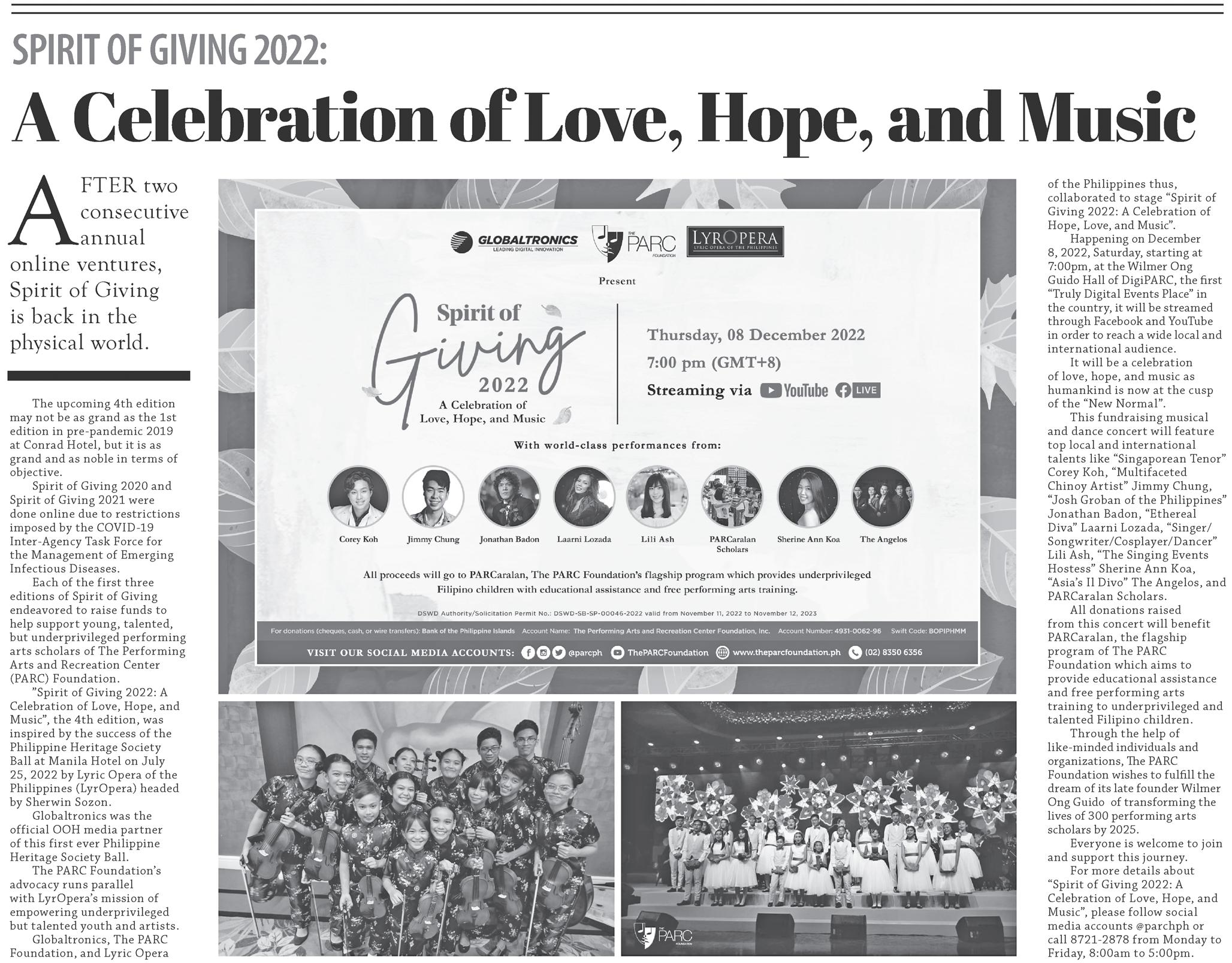
Despite its importance, the world is facing a growing threat of shortages in the coming decades. The best mines are getting old and the few new dis coveries are either in difficult places to operate, or face years of opposition to development.
The history of commodity markets shows that looming deficits tend to spur new discoveries and technolo gies. The US shale boom in the 2010s turned the oil market on its head, while breakthroughs in nickel process ing upended supply forecasts.
But new discoveries in copper are increasingly unlikely, given the long history of mining—evidence of copper usage has been traced back to at least
8,000 BC in what is now Turkey and Iraq. That means most of the world’s great deposits have already been found and exploited; more than half the world’s 20 biggest copper mines were discovered more than a century ago.
Waste dumps
YET the long history of copper mining also means there are massive amounts of metal sitting on the surface in waste dumps.
The reason is a principle as old as mining itself: ore is pulled up from the earth, the easiest metal is extracted, and anything too difficult or expensive to process is tossed aside as waste. Over the past decade alone, an estimated 43 million tons of copper have been mined but never processed, worth more than $2 trillion at current prices, creating huge opportunities for anyone who can successfully recover those riches.
To be sure, it’s not a new concept to reprocess mine waste when technol ogy improves or prices rise. But that just hasn’t been feasible for certain types of ore. And the breakthrough has opportunities far beyond waste dumps—there are millions more tons still underground that haven’t been viable to mine.
Much depends on mining com panies’ willingness to install Jetti’s plants. But if the technology be comes fully embraced by the industry, the company estimates that as much as 8 million tons of additional copper could be produced each year by the
2040s—more than one third of last year’s total global mine production.
“The industry has accumulated this waste material forever,” said Jetti’s founder and chief executive officer, Mike Outwin. “They’ve been trying to come up with an answer for it on their own for a couple of decades and haven’t been able to.”
So far Jetti’s process has been run ning on just one mine, at Pinto Valley in Arizona. But the results have been so promising three of the world’s big gest copper miners—including BHP— have bought stakes in the company. Its latest fundraising was at a valuation of $2.5 billion.
Copper giant Freeport says it has also “initiated a commercial imple mentation this year at our Bagdad mine in Arizona to trial the technol ogy and will assess the results and continue to dialogue with Jetti on other opportunities to work together.”
Copper ores
SO what is the problem that Jetti is seeking to solve?
There are two main kinds of copper-bearing rock. The most com mon type, sulfide ores, are typically crushed, concentrated, and then turned into pure copper in a firerefining process. But that method isn’t suitable for oxidic ores, and the industry’s last big innovation came in the mid-1980s when it adapted an electro-chemical process to extract copper from oxide ores, providing a
major boost to supply.
Now, Jetti aims to apply its tech nology to recover copper from a com mon type of sulfide ore that couldn’t be economically processed via either route—the copper content is too low to justify the cost of refining, while the hard, non-reactive coating prevented the copper from being extracted in the lower-cost electro-chemical or “leach ing” process.
Jetti worked with the University of British Columbia to develop a chemical catalyst that breaks through the layer, so that the copper can be released us ing leaching without the need for high temperatures.
While Jetti’s process is the most advanced, Rio Tinto says it’s also cracked the challenge in lab trials. Rio has been offering its Nuton technol ogy as a sweetener to junior mining companies that it invests in: if the smaller firms successfully develop their mining projects, then Rio will deploy the Nuton process to boost profitability. It’s signed three such deals already this year.
“When you look at the size of the prize, the potential is enormous,” said Adam Burley, who runs the Rio project. “It’s too big to leave on the table.”
Rio wants Nuton to have produced a total of about 500,000 tons of cop per by the end of this decade, with hopes that the business may one day produce the annual equivalent of one of the world’s top-five copper mines.

Other major miners including Freeport, Codelco and Antofagasta Plc have all been working on in-house solutions at their own mines, though so far there has been little disclosed information on how successful these projects have been.
And there are limitations to how much can be achieved. The focus is on North and South America, and the progress will depend on whether the technology can be deployed across the major mines.
Yet for BHP, the fact that it is even discussing the future of Escondida, the world’s single biggest source of copper, with a small upstart is telling.
Negotiations have been underway for months, although one of the stick ing points in the talks has been Jetti’s insistence that it installs and runs its own plant at the host mine, according to the people familiar with the mat ter. There are also negotiations about how to split the profits.
Meanwhile, Rio, which is BHP’s ju nior partner at Escondida, is arguing that it wants the Nuton technology to also be considered, according to people familiar with the matter.
Jetti and BHP declined to com ment on the specific negotiations or deals.“Jetti is very real. It’s not lab tests or pilot plants. Jetti has been deployed commercially,’’ said Outwin. “Our part ners will make extraordinary profits from being able to utilize our process, and Jetti will do well.’’ With assistance from James Attwood and Mark Burton/Bloomberg.
BusinessMirror
Editor: Lyn Resurreccion • www.businessmirror.com.ph
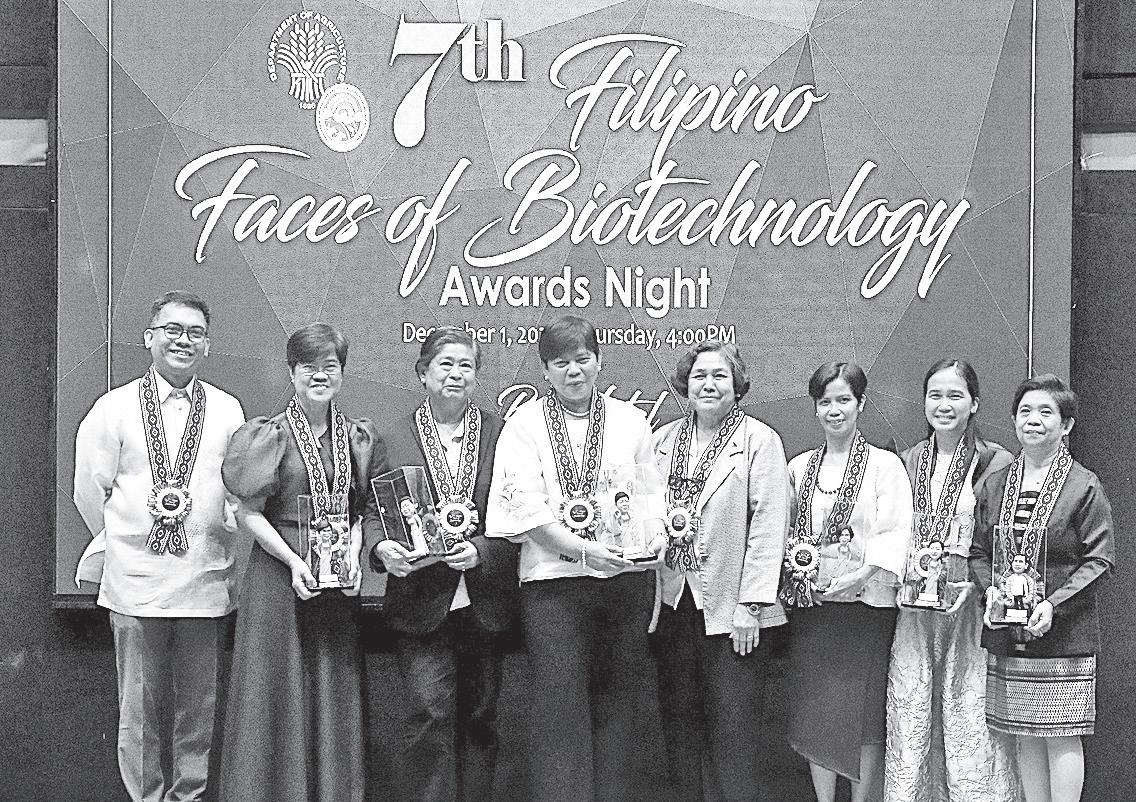
MANY RESEARCH, DEVELOPMENT AND INNOVATION PROJECTS NEEDS BRANDING FOR HIGHER IMPACT
DOST’S
By Lyn B. ResurreccionWHAT do these innovations have in common: the kit to determine microplastics test kit, gigantic mango, converted tricycle, textiles, 3d printing and electric tricycle?
T hey were among the exhibits on research and innovation that caught the interest of President Marcos Jr. during the recent Na tional Science and Technology Week (NSTW) held at the World Trade Center in Pasay City.
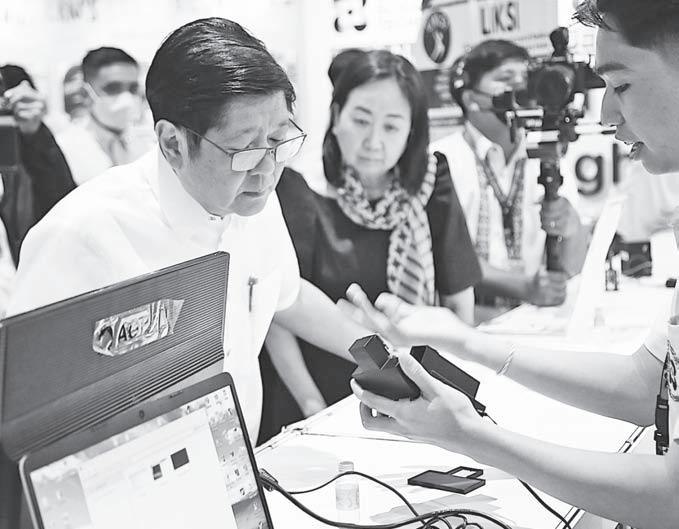
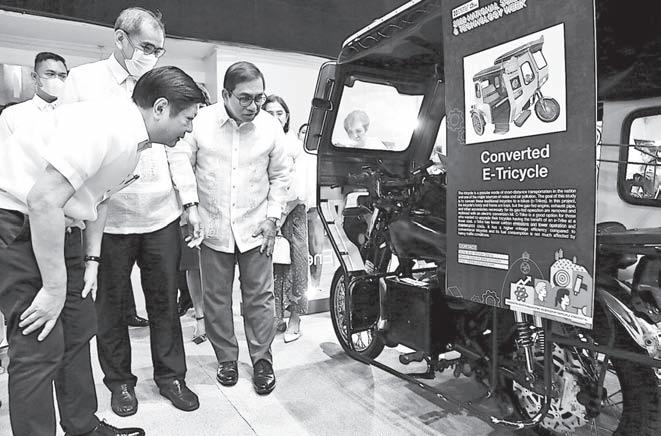
“ There was no exhibit that the president did not appreciate,” Sci ence Secretary Renato U. Solidum Jr. said during the hybrid news conference at NSTW.
P resident Marcos went around and viewed the products of re searches after ribbon cutting for the exhibits.
R egarding the president’s state ment in his speech on providing direction to research, development and innovations (RDIs), Solidum said that is already the plan under his helm at the Department of Sci ence and Technology (DOST) that started in July.
I think the president’s instruc tion is a clear manifestation of his support to the DOST and he has high hopes that we can deliver. It is also a manifestation of positive clues for us because we are already doing what he said, but we need to maximize our efforts in some,” he said.
S olidum added that the DOST has plans on branding many of
its projects to unify its efforts, including those from the regions, “into one national program in or der to have higher impact.”
W hen he accompanied Mr. Marcos in the exhibits, Solidum disclosed that the president give him an assignment to help hasten the delivery of aid after a disaster.
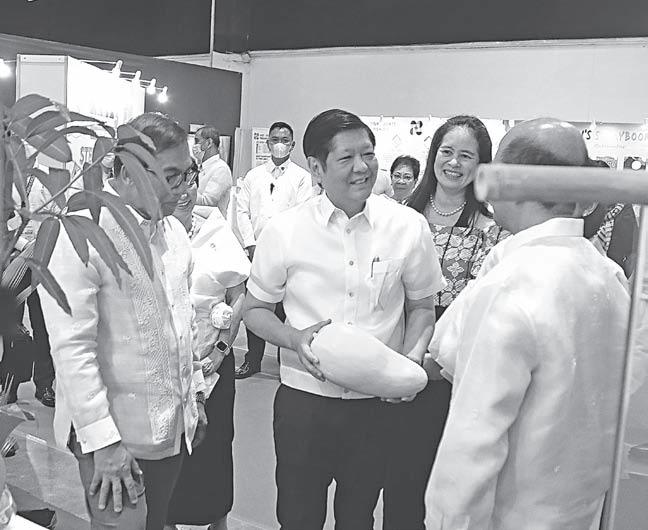
“ It is a reporting issue that he wants fast-tracked,” the DOST chief said.
He added that department will focus on the developing smart and sustainable communities.
Smart is also a brand name because there can be many tech nologies that we can share with the local governments,” he said.
H e explained that the “smart city, community, barangay, town or province does not only involve digital technology, but many oth er technologies that the DOST can offer.”
S olidum explained that the NSTW exhibits exemplified some of the current focus areas of the department.
A mong these are the creation of technology-based enterprises and jobs for regional and national de velopment, food security, energy, transportation, health and nutri tion, STEM (or science, technology
engineering and mathematics) education, climate and disaster resilience.
DOST agency heads talked about the focus of their respective offices during the news conference.
Building on tech developed vs Covid DR . Jaime C. Montoya, executive director of Philippine Council for Health Research and Development of the DOST (DOST-PCHRD), said the agency will continue in build ing on the technologies that it started against Covid-19.
He said the GenAmplify, a Fili pino health company that devel oped a diagnostic RT-PCR test kit against Covid19, is now using the same platform against monkey pox. The company was supported by the DOST-PCHRD.
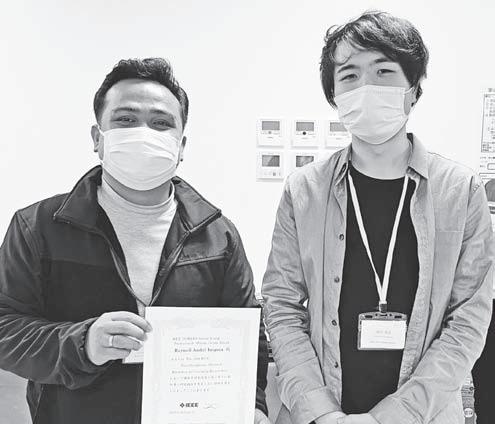
He added that another monitor ing technology that was supported by the DOST-PCHRD, the Feasi bility Analysis of Syndromic Sur veillance Using Spatio-Temporal Epidemiological Modeler for Early Detection of Diseases or Fassster, is currently being used by the De partment of Health.
I t is monitoring monkeypox entering the country using math ematical models.
M ontoya said another worldclass DOST-supported technol ogy, the Axis Knee System for the knee replacement, an affordable and high quality Filipino tech nology, is now addressing hip problems.
Native pig for lechon DR . Reynaldo V. Ebora, executive director of DOST-Philippine Council for Agriculture, Aquatic and Natural Resources Research and Develop ment (DOST-PCAARRD) said the agency will continue its programs
in agriculture and aquatic resources through the Industry Strategic Sci ence and Technology Program.
It will continue efforts in tech nology transfer against African swine fever, while it is collaborat ing with the Department of Agri culture in the development of test ing kits and in characterization of different isolates.
Ebora added that the agency has big efforts in technology transfer and is investing a lot of resources in Technology Business Incubators and in the creation of agricultural business hubs that were developed through RDIs by state universities and colleges (SUCs).
He said DOST-PCAARRD has efforts in biodiversity because there are still many components in marine and terrestrial resources that need to be characterized.
It is being assisted by research teams from the Mindanao Satte University, University of the Philippines Mindanao and other universities like Batangas State University.
In human resources develop ment, it is coordinating with the DOST-Science Education Institute for scholarships abroad for gradu ate programs that are not available in the Philippines.
In livestock and poultry, it will continue disseminating successful technologies that are being adapt ed by communities and industries, like in Itik Pinas and pure-bred native chicken.
He said the native pig, which has a purity rate of 90 percent, is being developed for lechon because of its tasty flavor.
Mobility, robotics and creative industry
DR . Enrico C. Paringit, execu tive director of DOST-Philippine
PhilSA
TOKYO,
Council for Industry, Energy, and Emerging Technology Research and Development, said the agency has a cohesive program on mobil ity, because it is converting old vehicles, making new ones like the electric (e)-jeep and is into developing charging stations.
“Our challenge in e-vehicles is that we have no chargers in many parts of the country,” Paringit said.
He said in the coming years, DOST-PCIEERD will have proj ects in maritime technology and industry.
Being an archipelagic and maritime nation, we would not achieve prosperity if we will not strengthen our maritime tech nologies and industries,” he said, like in making ships and small boats.
In low-carbon transport sys tem, with e-car, jeep, tricycles, there should also be e-boats, in cluding in the Roll-on, Roll-off boats in the inter-island trans port, he said.
PCIEERD is also into food pro cessing, to ensure food security so that they do not get spoiled, and have long shelf life.
The micro, small and medium enterprises (MSMEs) should be trained to adapt to artificial in telligence (AI) and robotics to be able to lead them to industry 4.0 in their processes so they could be more competitive, productive and efficient.
He pointed out that not only big industries currently use AI and robotics but also MSMEs.
In the creative industry, DOSTPCIEERD, based on the new law, Philippine Creative Industries Development Act, will help its agenda on preserving heritage, like in textiles and fibers.
In creative technology, such in film, animation and gaming, it is looking into improving the qual ity of making films, increase the number of animators and those making digital films.
Unicorn companies
UNDERSECRETARY for Regional Operations Sancho A. Mabborang said the Small Enterprise Upgrad ing Program (SETUP) was levelled up from 1.0 to 4.0 this year.
This means that the MSMEs can adapt to a technology so they could be among the companies under Industry 4.0. It includes mechanization of processes, uses AI, Internet of things and robotics in regions.
“We are also dreaming that our MSMEs will become unicorn companies,” Mabborang said.
He said the creation of smart communities will give stable and sustainable economic develop ment in regions.
Human resource for nuclear tech PHILIPPINE Nuclear Research In stitute (PNRI) Director Carlo Ar cilla said one requirement for the development of nuclear power is human resources.
He said they have talked with UP and Mapua University to ex plore teaching nuclear science and engineering subjects, and even offering courses.
“If there is no course on nuclear engineering being taught in the country, where will we get man power for a nuclear power plant?
In fact we are already teaching nuclear engineering subject at UP,” he said.

Arcilla added that PNRI is offer ing a PhD scholarship on nuclear science and engineering for for eign countries.
The IEEE Towers is an annual conference of university students and young researchers, including academic professors/scientists and working professionals in Japan, supported by the IEEE Young Professionals Affinity Group from Kansai, Sendai and Tokyo.
Inojosa’s research, titled: “Electrodynamic Analysis of a Geometry-Oriented Antenna for Low-Earth Orbit CubeSat,” was selected as one of the outstanding presentations.
The award is given to emerging researchers with exceptional presentations shared at the annual conference.
As part of the scholarship grant, AD Astra financially supported Inojosa’s short-term research engagement, a sandwich program, at the Laboratory of Lean Satellite Enterprises and In-Orbit Experiment and the Center for
Nanosatellite Testing at Kyushu Institute of Technology (KyuTech) in Japan.
The testing and measurements for his research were done at the facilities under the supervision of Prof. Mengu Cho of KyuTech.
“For my research, I did a computer modeling and optimization of a 920 MHz patch antenna for low-earth orbit CubeSat integration and investigated the actual performance of a fabricated prototype when used as a CubeSat payload,” Inojosa
explained.
Inojosa
CLINGING TO ANCIENT FAITH
India tribes seek religion status
GUDUTA, India—The ritual began with a thunderous roll of drums that echoed throughout the village. Women in colorful saris broke into an Indigenous folk dance, moving their feet to its galloping rhythm.
At the climax, 12 worship pers—proudly practicing a faith not officially recognized by the government—emerged from a mud house and marched toward a sacred grove believed to be the home of the village goddess.
Led by village chieftain Gasia Maranda, they carried religious to tems, including an earthen pitcher and a sacrificial ax.
Maranda and others in Guduta, a remote tribal village in India’s eastern Odisha state, are “Adiva sis,” or Indigenous tribespeople, who adhere to Sarna Dharma, a belief system that shares common threads with many ancient natureworshipping religions.
On that day inside the grove, worshippers displayed their rever ence for the natural world, mak ing circles around a Sal plant and three sacred stones, one each for the malevolent spirits they believe need pleased.
They knelt as Maranda smeared the stones with vermillion paste, bowed to the sacred plant and laid down fresh leaves covered in a cow dung paste.
“Our Gods are everywhere. We see more in nature than others,” Maranda said.
But the government does not legally acknowledge their faith— a fact that is becoming a rally ing point for change for some of the 5 million or so Indigenous tribespeople in India who follow Sarna Dharma.
They say formal recognition would help preserve their culture
and history in the wake of the slow erosion of Indigenous tribespeo ple’s rights.
Citizens are only allowed to align themselves with one of the six officially recognized re ligions—Hinduism, Buddhism, Christianity, Islam, Jainism and Sikhism.
While they can select the “Oth ers” category, many nature wor shippers have felt compelled by the religious affiliation system to associate with one of the named faiths.
Tribal groups have held protests in support of giving Sarna Dharma official religion status ahead of the upcoming national census, which has citizens state their religious affiliation.
The protests have gained mo mentum after the recent election of Droupadi Murmu, the first tribal woman to serve as India’s president, raising hopes of favor able change for the Indigenous population.
They number about 110 mil lion, according to the census. They are scattered across India and fragmented into hundreds of clans, with different legends, languages and words for their gods—many, but not all follow Sarna Dharma.
Salkhan Murmu, a former law maker and community activist who adheres to Sarna Dharma, is at the center of the protests push ing for government recognition. His sit-in demonstrations in sev eral states have drawn thousands.
At a recent protest in Ranchi, the capital of eastern Jharkhand state, demonstrators sat crosslegged on a highway blocking traf fic as Murmu spoke from a nearby stage and explained how anxieties over losing their religious iden tity and culture are driving the demand for recognition.
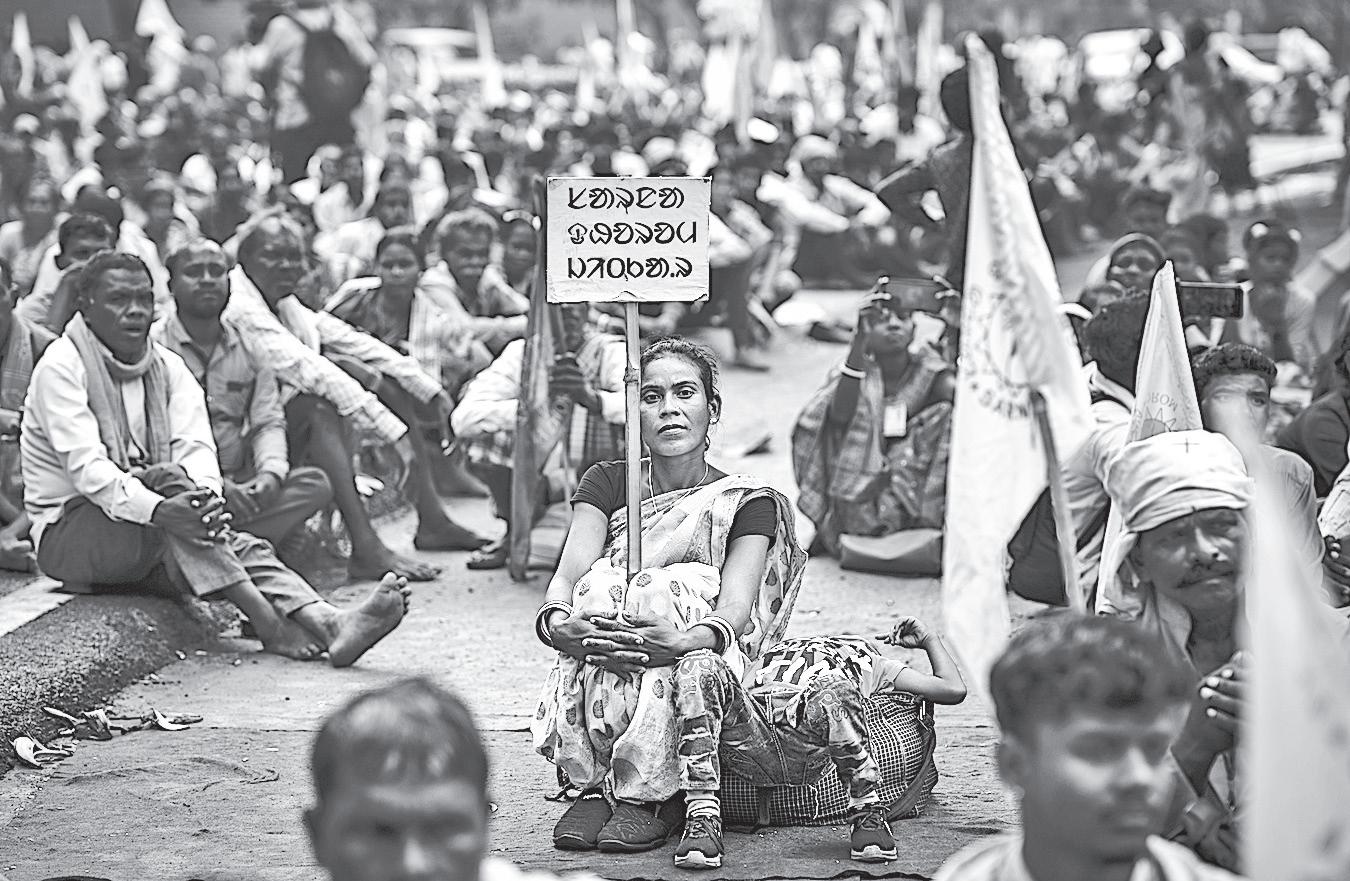
“This is a fight for our identity,” Murmu told the crowd, who held their fists in the air and shouted: “Victory to Sarna Dharma.”
Murmu is taking his cam paign into remote tribal vil lages. His message: If Sarna Dharma disappears, one of the country’s last links to its early inhabitants goes with it. It is a convincing argument evi denced by the increasing num ber of tribal members rallying behind him.
“If our religion will not get recognized by the government, I think we will wither away,” said Murmu, as a group of villagers huddled around him in Odisha’s Angarpada village.
Murmu’s efforts are just the lat
est push for official recognition.
In 2011, a government agency for Indigenous tribespeople asked the federal government to include Sarna Dharma as a separate reli gion code in that year’s census.
In 2020, the Jharkhand state, where tribespeople make up near ly 27 percent of the population, passed a resolution with a similar objective.
The federal government did not respond to either request.
One argument for granting Sarna Dharma recognition is the size of the nature worshipper population, said Karma Oraon, an anthropologist who taught at Ranchi University and has stud ied Indigenous tribes for decades.
The 2011 census shows more than half—a number close to 4.9 million—of those who selected the “Others” religion option identified as Sarna Dharma adherents.

Comparably, India’s Jain pop ulation—officially the country’s sixth largest faith group—is slightly more than 4.5 million people.
Decades ago, there were more options for Indigenous tribes people.
The census, started in 1871 under British rule, once allowed for the selection of “Animists,” “Aboriginal,” and “Tribes.”
The categories were removed in 1951 when the first census in independent India occurred.
Some hope giving Sarna Dhar ma official status could stem their faith’s existential threats, rang ing from migration to religious conversions.
“We are going through an iden tity crisis,” said Oraon.
His concerns have heightened after Hindu nationalist groups, in cluding Prime Minister Narendra Modi’s ruling party, have sought to bring nature worshippers into the Hindu fold.
These efforts stem from a long-held belief that India’s In digenous tribespeople are origi nally Hindus, but adherents of Sarna Dharma say their faith is different from monotheistic and polytheistic ones.
Sarna Dharma has no temples and scriptures. Its adherents don’t believe in heaven or hell and don’t have images of gods and goddesses. Unlike Hinduism, there is no caste system nor rebirth belief.
“Tribespeople might share some cultural ties with Hindus, but we have not assimilated into their religion,” said Oraon.
The gradual embrace of Hindu and Christian values by some In digenous tribal groups has exac erbated his concerns.
In the late 19th century, many tribespeople in Jharkhand, Od isha and other states renounced nature worship—some volun tarily and others coaxed by money, food and free educa tion—and converted to Chris tianity. Hindu and Muslim mis sionaries also chipped away at their numbers.
Most Christian missionaries are met with resistance these days, but conversions can still happen. However, for Sukhram Munda, a man in his late 80s, much is al ready gone.
He is the great-grandson of Birsa Munda, a 19th-century charismatic Indigenous leader who led his forest-bound com munity in revolt against British colonialists.
Munda’s legend grew after his death and statues of him appeared in almost every tribal village in the state. Soon, a man who wor shipped nature was worshipped by his own people.
But Munda’s religion barely sur vived conversions in his ancestral Ulihatu village in Jharkhand. Half of his descendants became Chris tians, Sukhram said. Now, the first thing visitors see is a church, a large white building that stands out against the green of the sur rounding forests.
“This used to be the village where we worshipped nature,” said Sukhram. “Now half of the people don’t even remember the religion their ancestors followed.”
Sheikh Saaliq/Associated Press2 Manila churches declared archdiocesan shrines

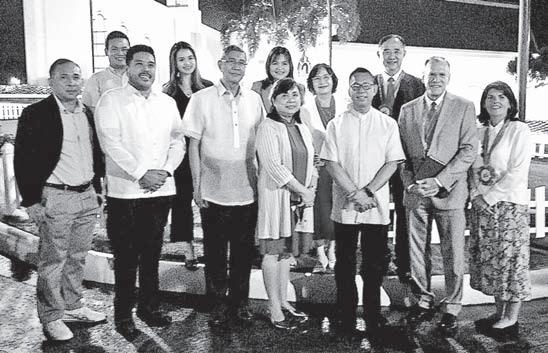
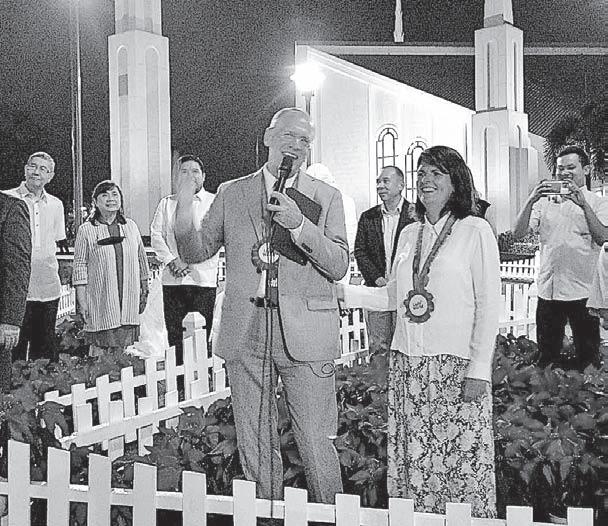
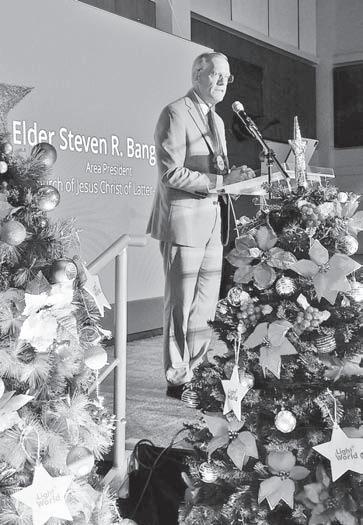
CARDINAL Jose Advincula has decreed the elevation of two parish churches in Manila to the rank of archdiocesan shrine.
The new status of Nuestra Señora del Perpetuo Socorro Parish (NSPS) in Sampaloc and San Vicente de Paul Parish (SVPP) in Ermita was provided in a new decree.
In his November 27 decree, the cardinal approved that the SVP Parish on San Marcelino Street will be conferred the title of the Archdiocesan Shrine of Our Lady of the Miraculous Medal.
“On the Feast of Our Lady of the Miraculous Medal, we received a gift,” the parish said. “We give thanks to the Lord for this blessing.”
The parish in Sampaloc’s Calamba corner Instruccion Streets, meanwhile, will be known as the Archdiocesan Shrine of Nuestra Señora del
Perpetuo Socorro.
The decree of erection of NSPS Parish as archdiocesan shrine was given on November 2, but it was only made public on November 27.

To be a diocesan shrine, a church, among other requirements, must be a place of historical significance,
prayer and pilgrimage for a special reason of piety.
When these requirements are met, the parish petitions the bishop to canonically elevate the church.
Meanwhile, for a church to be declared a national shrine, the bishops’ conference must give its approval.

Biodiversity Sunday
Financing biodiversity: Is mining a viable source?
By Jonathan L. MayugaSEVERAL countries are now training their eyes on envi ronmentally harmful subsi dies, or programs that encourage unsustainable production or con sumption and harm nature by ex hausting natural resources, degrad ing global ecosystems and damaging planetary health.
These countries are hoping to narrow the huge budget gap in bio diversity to ensure sustainability.
As part of the United Nations Development Programme Biodi versity Finance Initiative’s (UN DP-Biofin) Regional Dialogue that was held in the Philippines last month, selected Biofin member countries have presented poten tial biodiversity finance solutions during a special session at the Makiling Botanical Garden in Los Baños, Laguna.
Biofin members, represented by over 70 biodiversity finance ex perts from Europe and Asia, show cased various approaches, showing through posters, how they intend to address the huge biodiversity gap, and hopefully help avoid the extinction of global species.
Financing biodiversity
“ BIODIVERSITY finance finds ways to raise and manage funds to sustainably manage biodiversity. The wealth of our participants’ experiences presents an array of fundraising solutions for the postCovid world,” Biofin Global Man ager Onno van den Heuvel said during the kick-off ceremonies of the three-day dialogue.
He said biodiversity invest ments can stave off extinction. In fact, he said every $1 billion invest ment reduces the total number of threatened plant and animal spe cies by 0.57 percent.
However, just 0.19 percent of the world’s cumulative GDP is allotted for biodiversity, Heuvel pointed out.

More than halting extinction, biodiversity finance protects the natural systems people rely on, he added.
The dialogue sessions tack led results-based budgeting, public-private finance part nerships, nature financial dis closure, insurance, compensa tion mechanisms, repurposing harmful subsidies, debt instru ments, Islamic finance, protect ed area finance, crowdfunding, lotteries, carbon-based finance
instruments, offsets, task forc es on nature-related financial disclosures, coral reef insur ance, plus practical Covid-19 recovery strategies.
Unique biodiversity finance solutions
SEVERAL country representatives presented through creative posters how they intended to narrow the biodiversity financing gap, offer solutions to the challenge of fund ing biodiversity protection and conservation in their respective country and in others.
“Ten countries presented their biodiversity finance solutions in the session. All solutions were unique. This gives other countries new ideas and learning experi ences that may help address policy issues in implementing their own biodiversity finance solutions,” Ozlem Culhaci of Biofin Global told the BusinessMirror in an interview on November 10.
She said to make the finance so lutions work and become a reality, countries must work with policymakers, such as the national gov ernment’s executive and legisla tive branches, local governments, and other stakeholders they intend to partner with.
Philippine Biodiversity Strategy and Action Plan
IN response to the alarming loss in biodiversity, the Philippine government has put in place the Philippine Biodiversity Strat egy and Action Plan (PBSAP) 2015-2028.
It is a strategic instrument, which vision is that by 2028, the country’s biodiversity is restored and rehabilitated, valued, ef fectively managed and secured,
mainlining ecosystem services to sustain healthy, resilient Filipino communities and delivering ben efits to all.
The PBSAP integrates and mainstreams the objectives of the Convention on Biological Diversity (CBD), an international treaty to which the Philippines is a party, into the national development and sectoral planning framework that includes measurable targets for CBD commitments.
The objectives include sustain able use of the country’s biodiver sity components, and fair and eq uitable sharing of benefits arising out of the utilization of genetic resources.
Budget gap
TO implement PBSAP, the govern ment said P24 billion is needed yearly to cover the costs of park management, personnel, equip ment, research, operations, plus other overheads.
A baseline study conducted by the Department of Environ mental and Natural Resources’ Biodiversity Management Bu reau (DENR-BMB) and Biofin, however, found out that from 2008 to 2013, just P5 billion was allotted for biodiversity initia tives, or a mere 0.31 percent of the national budget.
This means Philippine biodiver sity projects are only 20-percent funded. Hence, this scenario pres ents a clear 80 percent financing gap that needs to be addressed.
Mining and biodiversity
A MULTIBILLION-DOLLAR indus try, taxes from mining is now being eyed by the government to boost its post-Covid-19 recovery effort.
Biodiversity finance experts,
at the same time, are also looking into the steady flow of investments in mining for the protection and conservation of the country’s rich biodiversity.
A country considered to be one of the megadiverse countries in the world but also a biodiversity hotspot due to the rapid rate of biodiversity loss, experts say the mining industry in the Philip pines is a possible source of funds for biodiversity conservation and protection.
Its proposal, “Enhancing biodiversity conservation and protection in mining activi ties in the Philippines,” tells of the huge potential of mining, a highly extractive industry and one of the biggest threats to the country’s biodiversity, in ad dressing the huge biodiversity financing gap.
Huge potential MINING has rich deposits of gold, copper, nickel and other minerals still waiting to be tapped.
Currently, there are 51 oper ating metallic mines, including 12 gold, 3 copper, 32 nickel and 4 iron in the Philippines as of January 2022.
There are also 56 operating nonmetallic mines that extract limestone, marbleized limestone, silica, aggregate quarries, dolo mite, clay, sand and gravel, vol canic tuff and greywacke, a dark coarse-grained sandstone.
Mainstreaming biodiversity “ BY mainstreaming biodiver sity conservation and protec tion in mining activities, half, or P20 billion or $3.5 billion, can be redirected to biodiver sity,” said Anabelle Plantilla,
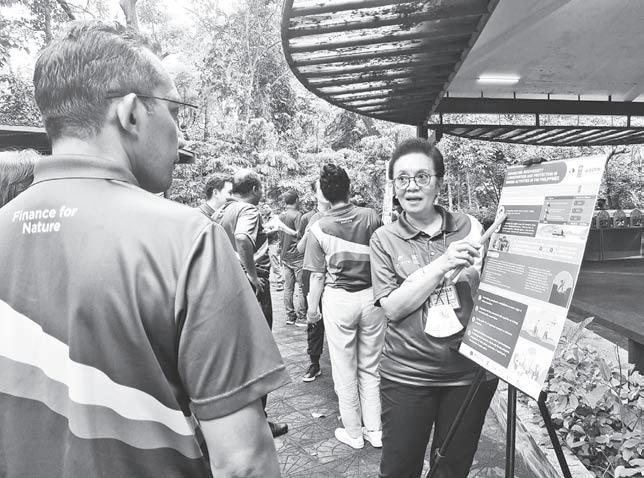
Cavite village releases sea turtle hatchlings

NAIC, Cavite—A pawi kan , or sea turtle, con servation center re leased 78 olive ridley hatch lings late last month to their natural habitat in Barangay Labac in this municipality as the breeding season starts.
Municipal Councilors Tere Puno and Eimeren Nazareno, together with Naic Tourism Head Lady Anne Lopez, led the release of the hatchlings to the sea before sunset.
The Labac Conservation Facil ity was established to protect the pawikan eggs.
Olive ridley is one of the seven sea turtle species, which are now endangered. The others are flat back, green, hawksbill, leather back, loggerhead and Kemp’s rid ley. Five of them can be found in the country.
According to Barangay Labac Chairman Roger Bilugan more hatchlings are scheduled to be released to the sea in the next few days although many were
affected by Typhoon Paeng on October 30.
The coastal villages of Naic, es pecially in Labac, were among the areas that were severely damaged
by Paeng, with a knee-high seawater rise on the beach.
More than 300 olive ridley sea turtle eggs were affected in the nesting area of the more than
2,000 eggs at the hatchery facility. They had to be cultivated to save from the wetting of the sand in their breeding ground. Some were broken due to the wetting caused by Paeng.
“Just last night, three turtles came to lay their eggs here at the facility, two of them with tags, while one had no tag. Meaning they came here to lay their eggs,” Bilugan said in Filipino in an in terview.
“The tags with dates written on them serve as signs that [the turtles] were from here,” Bilugan added.
An egg takes 60 days in the hatchery before it finally hatches and is returned to its natural habi tat in the ocean.
One Pawikan, an environ mental conservation organiza tion, donated 30 tonner bags to Labac Conservation Facility in order to create a revetment wall to hold and lessen the erosion of the nesting areas.
Biofin Philippines Project Manager told the Business Mirror on November 9.
“There’s already a policy in place that can make this happen,” she added.
Republic Act 7942, or the Phil ippine Mining Act of 1995, is “one of the stringent mining law in the world.”
According to Plantilla, through the development and approval of the DENR, the agency mandated to manage the country’s natural wealth and its policy issuance, specifically Administrative Order 2022-04, adequate measures for responsible on-shore and off-shore mining toward ensuring biodiver sity conservation and protection are provided.
This include progressive and final rehabilitation of mined-out areas that would help the min ing sector easily narrow the huge biodiversity financing gap in the country.
Mining companies’ commitment MINING companies are required to implement various programs, such as Social Development and Management Programs (SDMP), in which it has to set aside a por tion of the total project cost for programs that will benefit the host communities.
According to Biofin Philippines, the total cumulative mining com pany fund as of December 2021 stands at P416.29 billion (approxi mately $7.1 billion).
For the SDMP alone, around P26 billion is committed to be spent.
Meanwhile, for the Environ ment Protection and Enhance ment Program, mining companies are set to spend around P384.7 billion.
For the Final Mine Rehabili tation and/or Decommissioning Plan, P5.51 billion is allocated by the industry.
Proposed biodiversity actions for miners
ACCORDING to Plantilla, min ing companies can contribute to biodiversity conservation and protection by simply undertaking progressive rehabilitation at every stage of their operation.
She said they could employ full-time personnel with ecology and biodiversity conservation ex pertise.
“Of course, we know that com pletely restoring what was lost after mining is impossible. But somehow, we can still recover some of the biodiversity that was lost through progressive rehabili tation,” she pointed out.
It was proposed to strictly set aside 5 percent of approved tenements as a reference ecosys tem from which rehabilitation teams can get their idea of how much biodiversity is needed to be brought back.
At the same time, by integrat ing biodiversity conservation in the SDMP of mining companies’ biodiversity-friendly enterprises, in the propagation of native plants and in the promotion of agrofor estry development of green parks, it can boost the country’s effort of conserving and protecting its rich biodiversity.

The question is: Will it work to save the country’s endangered flora and fauna from extinction?
WILDLIFE CONFERENCE BOOSTS PROTECTION FOR

PANAMA CITY—An international wildlife conference moved to enact some of the most significant protection for shark species targeted in the fin trade and scores of turtles, lizards and frogs, whose numbers are being decimated by the pet trade.
The Convention on International Trade in Endangered Species of Wild Fauna and Flora (CITES) ended on November 26 in Panama.
In a record for the conference, delegates enacted protections for over 500 species.
The United Nations wildlife conference also rejected a proposal to reopen the ivory trade. An ivory ban was enacted in 1989.
“The Parties to CITES are fully aware of their responsibility to address the biodiversity loss crisis by taking action to ensure that the international trade in wildlife is sustainable, legal and traceable,” Secretary General Ivonne Higuero said in a statement.
“Trade underpins human well-being, but we need to mend our relationship with nature,” she said. “The decisions coming from this meeting will serve the interests of conservation and wildlife trade, that doesn’t threaten the existence of species of plants and animals in the wild, for future generations.”
SHARKS, TURTLES
The international wildlife trade treaty, which was adopted 49 years ago in Washington, D.C., has been praised for helping stem the illegal and unsustainable trade in ivory and rhino horns as well as in whales and sea turtles.
But it has come under fire for its limitations, including its reliance on cash-strapped developing countries to combat illegal trade that’s become a lucrative $10 billion-a-year business.
One of the biggest achievement this year was increasing or providing protection for more than 90 shark species, including 54 species of requiem sharks, the bonnethead shark, three species of hammerhead shark and 37 species of guitarfish.
Many had never before had trade protection and now, under Appendix II, the commercial trade will be regulated.
Global shark populations are declining, with annual deaths due to fisheries reaching about 100 million. The sharks are sought mostly for their fins, which are used in shark fin soup, a popular delicacy in China and elsewhere in Asia.
Kathia Martínez/Associated PressSOUL-SEARCHING GERMANY’S FALL
AL KHOR, Qatar—Another World Cup, another flop.
Former soccer power Germany is facing another round of soul-searching after going out of the sport’s most important tournament at the first stage for the second time in a row.
Germany’s players spoke afterward of good performances and missed chances—as they’ve done before.

But no one had any real answers to the team’s problems.
“There are 25 experts standing together here. You can all advise each other and then agree on a few details,” Thomas Müller said after Germany’s 4-2 win over Costa Rica on Thursday.
Germany’s fate was effectively decided when it lost its first game, 2-1, to Japan, then followed up with a 1-1 draw with Spain.
It left Germany at the bottom of Group E and dependent on a favor from Spain. It never came as Japan defeated Spain in its final game to top the group. Spain progressed ahead of Germany on goal difference.
“I never look at another team, it’s up to us,” Germany coach Hansi Flick said of relying on Spain. “I think ultimately the sum of everything contributed to us being eliminated. We had enough chances, whether in the first half or the first 60 minutes of the game against Japan, or even at the end against Spain, when we had another huge opportunity. You really have to take those chances.”
What Flick failed to mention is that Spain also missed a host of chances to put its game against Germany out of reach before Niclas Füllkrug’s late
equalizer.
“We haven’t been able to live up to expectations at the tournaments in recent years, because as a team, I would say we don’t really have specialists running around everywhere. We have a lot of players who are very talented. Yes,” Müller said before trailing off and leaving those at the emedia conference to finish his thoughts.
Germany, the 2014 World Cup champion, also crashed out during the group phase at the 2018 tournament in Russia. At last year’s coronaviruspostponed European Championship, Germany was knocked out in the second round.
“I think really, we can’t say where we are,” Germany captain Manuel Neuer said of the team’s place in world soccer.
Prior to the 2018 World Cup, Germany had reached at least the semifinal stage of every major competition it entered since the 2006 World Cup, which it hosted.
“I joined the team in 2016. Germany was always in the semifinal before that,” midfielder Joshua Kimmich said.“Then I come in and we’re out (of the World Cup) in the first stage and last year in the second round (of the European Championship), it’s hard to take.”
IRAN BACK HOME AMID PROTESTS
IRAN’S national team received a subdued welcome home after its World Cup defeat against the United States, a match played against the backdrop of ongoing anti-government protests in Iran.
One Iranian man was shot dead
celebrating the American victory.
The players returned from Qatar late Wednesday, a day after their 1-0 loss. Antigovernment protesters, considering the team a symbol of Iran’s clerical rulers, had celebrated the loss in some Iranian cities with fireworks and cheers.
One man was shot dead by Iranian security forces in northwest Iran for honking his car horn in support of the US victory, the Oslo-based rights monitor Iran Human Rights reported on Thursday.
Iran’s treatment of the players will likely be scrutinized because they refrained from singing the Islamic Republic’s national anthem during their opening World Cup match. Many considered the move a show of solidarity with the protests. The team did sing the anthem in subsequent matches.
A few dozen fans greeted the national team’s return at Tehran’s international airport late Wednesday, with people cheering and waving the Iranian flag.
Yet the players have faced biting criticism from anti-government protesters who have blamed the team for not being more vocal about the security force’s violent put down of the demonstrations. Human rights groups say over 400 protesters have been killed in the crackdown, with thousands more arrested.
An image of players bowing in the presence of President Ebrahim Raisi before setting off to the tournament was widely criticized by activists on social media. A hardline cleric, Raisi has likened protesters to “flies” and dismissed the movement as a foreign plot, without offering any proof.
Mehran Samak, 27, was shot dead after honking his car in support of the US win after
Tuesday’s match in the city of Bandar Anzali in northwest Iran. Oslo-based Iran Human Rights reported he was “shot in the head by state forces when he went out to celebrate the Islamic Republic’s loss.”
Samak is also a childhood friend of Iranian midfielder Saeed Ezatollahi, who mourned his death on his social media. But again he received criticism from activists for not explicitly stating Samak was killed by government forces.
Many Iranian celebrities have however been targeted by the government with arrest or other measures for speaking out on behalf of the protesters.
Iranian officials acknowledged but downplayed compatriots celebrating the US win. Gen. Hossein Salami, chief of the paramilitary Revolutionary Guard, said those who had celebrated were doing so on “behalf of the enemies,” adding “it is not important to us.” His comments appeared in the semi-official Tasnim news agency.
A former culture minister and editor-in-chief of the Ettelaat newspaper, Abbas Salehi, who has close ties with Iranian Supreme Leader Ayatollah Ali Khamenei, tweeted: “Iran’s defeat in the game against America was bitter, but even more bitter was the happiness of some people.”
Iran was eliminated from the tournament in Qatar following the loss to the U.S. on Tuesday that saw the players scrambling to score a goal in the last remaining minutes of the game. Striker Sardar Azmoun told reporters he was not satisfied with his performance in the last match.
It was the sixth time Iran has participated in the World Cup. AP
‘Wheels for Work’ program on National Bike Day celebration
He’s now the coach, and he’s made amends.
Japan won its World Cup group on Thursday after beating 2010 champion Spain 2-1 at the Khalifa International Stadium. Last week, the team defeated 2014 champion Germany by the same score at the same venue.
As time was winding down against Spain, Moriyasu was thinking about that game in Qatar

Redemption for Japanese coach in Qatar
against Iraq in 1993 that cost the team a spot in the next year’s tournament.
“About one minute before the end,”Moriyasu said after the win over Spain,“I remembered the tragedy in Doha.”

Leading 2-1 in the team’s final qualifier and knowing one goal for the opposition would spell the end, Japan conceded in stoppage time. Their World Cup hopes were dashed, and so was Moriyasu’s chances of playing at the biggest soccer tournament in the world.
This time it was different. This time the defense held it together. This time the 54-yearold Moriyasu got his Hollywood ending by winning Group E.
“I could feel that the times have changed,” Moriyasu said, praising his team’s aggressive defending. “They are playing a new kind of soccer, that’s how I felt.”
Japan’s resistance on the field was typified by 34-year-old captain Maya Yoshida. The veteran central defender reacted fastest when a loose ball in the 90th minute bounced in the goalmouth, up in front of a gaping empty net, after goalkeeper Shuichi Gonda blocked a shot by Jordi Alba.
Yoshida twisted his body to beat Marco Asensio to the ball and clear the danger. When Spain forward Dani Olmo took control seconds later, Gonda blocked his shot with a smothering dive.
On the offensive side, Japan scored in the 48th and 51st minutes. Against Germany, the goals came in the 75th and 83rd.
“In 10 minutes we were dismantled,” Spain coach Luis Enrique said.
Up next is Croatia, a team that reached the final four years ago in Russia. Another victory on Monday would put Japan in the World Cup quarterfinals for the first time.
“We,” the coach said, “are gifting this win to the people of Japan.” AP
Klinsmann leads legendary FIFA team analyzing World Cup games
DOHA, Qatar—The black SUV packed with soccer fans wearing Lionel Messi shirts pulls up alongside a World Cup -branded vehicle, both inching forward in late-night traffic after leaving Argentina’s game against Poland.
Two men in the Jeep Wrangler with Bahrain license plates look over, waving and smiling after seeing Messi play in the 2-0 victory but oblivious to the storied occupants in the back seat of the van.
Jurgen Klinsmann, Faryd Mondragón and Cha Du-ri.
One is a World Cup winner. Together, they were selected for eight World Cup tournaments. Altogether, they made 235 appearances for Germany, Colombia and South Korea.
And now they are on the same broadcasting team making rapid-reaction podcasts that break down team tactics and strategy as they drive to the next stadium or back to their hotel in the upscale Pearl district.
So fresh is the data-driven analysis, the FIFA vehicle is loaded with microphones primed and recording about 20 minutes after the final whistle at Stadium 974.
The Associated Press joined one of FIFA’s podcast crews—three soccer greats and three expert performance analysts—making their first draft of the Argentina-Poland match for what will become FIFA’s official tactical history of the World Cup in Qatar.
The privileged media access even extended to Mondragón ceding his usual seat next to their regular driver.
a call from a Colombian TV channel that wants him on screen.
The 10-minute conversation wraps up while still in the snaking traffic jam, while all are illuminated by the interior light should anyone in neighboring vehicles raise their gaze from their phone. They don’t.
Klinsmann says fans “sometimes wave” at the three players, while Mondragon taps the passenger side window and quips: “It’s bullet proof.”
It was different leaving the stadium as all three patiently posed for selfies with fans as they walked down three flights of steps after leaving their long desk at the front of the media tribune.
The FIFA technical team has a high-tech operation. Each uses an Apple tablet to see games from cameras at wide-angle vantage points on the halfway line and behind each goal. A vertical on-screen panel stores clips of key action and tactical insight.
The FIFA data expert shares instant analysis that can also be given to official broadcasters.
THE
Business Club and Ayala Foundation donated 72 bikes nationwide via the Wheels For Work Program during the recent celebration of the National Bicycle Day.


A total of 52 of the bikes were awarded to the winners of this year’s National Bike Lane Awards including Iloilo City, Quezon City, Mandaue City, Alaminos City and Pasig City.
The bikes will be given to select employees of the winning local government units who have no means of transportation to and from work.
The other 20 bikes were given to janitors, security guards and other workers at turnover events in Cebu and Cagayan de Oro.
The bikes were donated by Ayala Foundation partners and Makati Business Club members, among them AC Infra, Entrego, Grab, McDonald’s, Megawide, Monark Equipment, SM Cares and White & Case.
The donor companies expressed support for more concrete infrastructure and policy changes that would make commuting by bicycle safer, more attractive, and comfortable for all Filipinos,
especially members of the Filipino workforce.
“It makes good business sense and environmental sense for employers to actively support employees who commute by bike on a day to day basis,” White & Case’s Mark Hernandez said.
“More businesses [should] support bike commuters through Wheels for Work of Makati Business Club because it is good for the environment and it can stimulate healthier and happier workforce that resonates to higher productivity,” Mely Purificacion of Monark said.
“It’s very important for business to be more involved and to participate because it’s not just society that is responsible, but even the companies need to help contribute towards a productive and sustainable future,” said Lem Gardose of Megawide.
The Wheels for Work is a joint project of the Ayala Foundation and the Makati Business Club to donate bikes to Filipino workers nationwide to help mobilize the workforce and provide a sustainable means of livelihood.
“The goalkeeper has to be in the front because he’s the biggest,” said Klinsmann, who settled for this journey in the middle seat of the middle row—a hub of the crosstalk with a clear view of the road ahead.

A World Cup winner with West Germany in 1990 and twice a World Cup coach— with Germany in 2006 and the United States in 2014—Klinsmann is de facto leader of this broadcasting team. It has an easy camaraderie.
There’s a running joke on “soccer versus football” language and Klinsmann polls the AP on “shin pads or shin guards?” He’s clearly a “shin guards” man and the reply of shin pads draws a cheer from the British contingent.
Recording starts after the van crests the parking lot speed bumps and the eight-seater turns onto Ras Abu Abboud Expressway.
The talk is crisply delivered and collegial. All six contribute over an ambient backdrop of soft clicks from the car’s indicator and Mondragón’s phone ring tone. It beeps twice before he silences
FIFA has committed to publishing reams of data within four hours of each game. It is processed by a team of analysts working in Britain, a World Cup debut project to inform and educate fans and coaches worldwide.
The bigger picture is the FIFA Training Centre website, a free resource aiming to teach coaches in all 211 member countries. It is overseen by Arsène Wenger, who once coached Klinsmann at Monaco. “The wish from FIFA’s side was, ‘Help us understand what is really relevant,’” Klinsmann said.
“For the younger generation it’s no big deal, but for us it’s, ‘OK, how do we connect all this data, with all the statistics. Does it make sense?’
“We are kind of bouncing off each other, the data guys with the soccer guys. We keep learning.”
FIFA has made all the podcasts, video clips and training ground routines freely available. Even for those passengers stuck with their phone in traffic.
44th Year of CatholiC Mass Media awards








Mass media workers, institutions honored in awards presentation


World Communications Day. In his keynote address, Manila Archbishop and CMMA Honorary Chairman Jose F. Cardinal Advincula explained that this statement is an invitation to us “to get out of our ivory towers and fortresses, open our doors and meet one another as fellow travelers on the same road heading towards the same destination.”
Advincula also talked about the biggest temptation for mass media practitioners and social media influencers nowadays, which is “to hide behind the anonymity of their platforms with the aim to gain attention and profit at the expense of truth and humanity.” This practice, Advincula stressed, is not communication but commodification, which, unfortunately, seems to be the downward spiral that dominates the media today. “Mass communication is at the service of human promotion and not of dehumanization or desacralization of the human person. Mass media’s role is to seek the facts that lead to objective truth, not my subjective truth that bends the facts,” he said.
THE Catholic Mass Media Awards (CMMA) celebrated its 44th Year by honoring mass media practitioners and organizations that exemplified Christian Values and Ideals in an awards presentation held on November 23, 2022, at the Manila Grand Opera Hotel in Sta. Cruz, Manila.


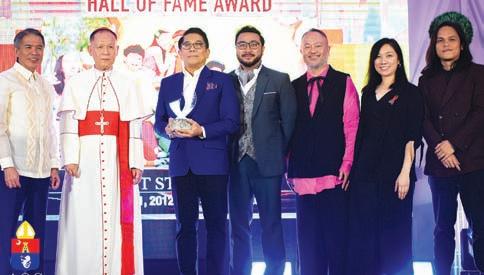


After a series of deliberations by the panels of judges, a total of 59 entries emerged as winners out of the 166 finalists in the 37 mass media categories of print, radio, television, music, advertising the Internet, and Student CMMA. Prior to the awards night, the winners were announced on the official Facebook page of the CMMA.

CMMA Chairman D. Edgard A. Cabangon welcomed the winners, CMMA board of trustees and officers, and guests to the awards night, which was held face-to-face for the first time in two years. In his welcome remarks, Cabangon expressed delight over the chance to once again gather in person to celebrate the momentous event. “It is an
amazing feeling that we are able to enjoy each other’s company as we honor tonight’s outstanding communicators in various fields,” he said.
Cabangon also highlighted the important work of mass media professionals, especially now that deviation from the truthfulness and accuracy of relevant information has become a possibility with the emergence of various communication channels. “This is precisely the reason why we are thankful for our communicators and media practitioners who are with us tonight. We commend your courage and dedication to getting the important message across to the public. Using your talents and skills in producing worthy media programs and other artistic works that showcase Christian values and faith, you have become instrumental in safeguarding the truth of Christian faith and morals,” Cabangon said.
This year, the theme of the CMMA is “Come and see (John 1:46): Communicating by encountering people where and as they are,” which is taken from the message of His Holiness Pope Francis for

Before ending his speech with a prayer, Cardinal Advincula gave a challenge to mass media professionals. “This is what our world, whether virtual or real, desperately needs: a sense of fraternity and solidarity, a vision of peace and harmony, a dream of a shared future and destiny. As media practitioners, I challenge all of you to use whatever platform or influence you have to put these aspirations into reality, one day at a time; one message at a time,” said Advincula.
This year, two more awardees were elevated to the CMMA Hall of Fame after winning in their respective categories five times. They are the ABS-CBN Corporation Creative Communications Management Division, recipient of the award for Best Station ID in the years 2010, 2011, 2012, 2014, 2016 and 2021; and phjesuit.org, recipient of the award for Best Website in the years 2017, 2018, 2019, 2020 and 2021.

Watch the full coverage of the 44th Catholic Mass Media Awards Presentation on CNN Philippines on Sunday, December 4, at 10:00 pm.

2022 CMMA WINNERS & SPECIAL CITATIONS
 SPONSORED BY:
SPONSORED BY:





 CMMA chairman D. Edgard A. Cabangon delivers his welcome remarks.
His Eminence Jose F. Cardinal Advincula, D.D., archbishop of Manila and CMMA honorary chairman, delivers his inspirational message.
CMMA chairman D. Edgard A. Cabangon delivers his welcome remarks.
His Eminence Jose F. Cardinal Advincula, D.D., archbishop of Manila and CMMA honorary chairman, delivers his inspirational message.


Publisher : Editor-In-Chief : Concept : Y2Z Editor : SoundStrip Editor : Group Creative Director : Graphic Designers : Contributing Writers : Columnists : Photographers :

T. Anthony C. Cabangon Lourdes M. Fernandez Aldwin M. Tolosa
Jt Nisay Edwin P. Sallan Eduardo A. Davad
Niggel Figueroa Anabelle O. Flores
Tony M. Maghirang, Rick Olivares, Leony Garcia, Patrick Miguel
Kaye VillagomezLosorata Annie S. Alejo Bernard P. Testa Nonie Reyes Y2Z & SOUNDSTRIP are published and distributed free every Sunday by the Philippine Business Daily Mirror Publishing Inc. as a project of the
The Philippine Business Mirror Publishing, Inc., with offices on the 3rd Floor of Dominga Building III 2113 Chino Roces Avenue corner Dela Rosa Street, Makati City, Philippines. Tel. Nos. (Editorial) 817-9467; 813-0725. Fax line: 813-7025
Advertising Sales: 893-2019; 817-1351,817-2807.
Circulation: 893-1662; 814-0134 to 36. www.businessmirror.com.ph
LAST SONG SYNDROME
Press Hit Play on making their presence felt in the P-Pop scene
By Patrick V. MiguelBEFORE they were known as “Press Hit Play,” the P-Pop group was called “PHP”in 2019 to attribute Philippine music. But later in 2020, the boy band announced a new name still maintaining the acronym “PHP” but emerging now as “Press Hit Play.” Lead vocalist Chrls said the reason behind this decision is they wanted to take the group “to a higher level.”

“‘Yung name na PHP, ‘yung acronym is parang… ni-re-represent namin talaga is ‘yung Philippines so ‘yung PHP parang currency ng Pilipinas,” the lead vocalist added.
Chrls clarifies that PRESS. HIT. PLAY means creating songs that makes listeners undergo a case of “LSS”: Last song syndrome. “‘Once you press this hit song, it will always play on your mind,’ so kinuha namin’ yung mga taglines na yon sa PRESS, HIT, PLAY,” he said.
Before PHP existed, the band members were in different “groups” and doing their own individual pursuits until they decided to work together as a band, without holding any auditions.
Chrls explained, “We decided to form the group, bale wala kasing audition na nangyari sa amin, talagang magkaka-kilala kami na pinush namin ‘yung mga pangarap namin, [at] pinili naming makasama ang bawat isa.”
Forming the band was easier than expected since camaraderie is not an issue. They already knew each other since 2015 and have been friends since then.
Lead dancer JP shared that they originally started as a “cover group” in KPOP events. But throughout, their influences are starting to form from KPOP, OPM, and some Western music. JP added that they are all collectively into 90s boy bands. They used all of these influences and made their own songs, reeling away from the label of “cover group.”
As of writing, Press Hit Play has
now seven songs available in all music-streaming platforms. Their most-streamed song on Spotify is “Tell Me,” which currently has around 155,000 streams.
Chrls revealed that most of their songs are about their individual lives, and they chose to do this because they believe that it’s what people could mostly relate to. He reflects, “Most of it is galing sa amin or sa stories din namin na alam namin na ‘yung ibang mga tao ay naranasan din ‘yon.”
Before they were PHP AS mentioned, each member had their own individual pursuits before forming as a band.
Main vocalist Sev shared that music has always been a part of his life since high school, influenced heavily by the KPOP genre. He originally wanted to be a part of a KPOP group, but knowing the odds, he opted to compete in KPOP singing competition instead. Not until P-Pop existed, and his life changed since.
Like Sev, Chrls also was very much into music at a young age. But instead of KPOP, he was more into 90s boy bands like Backstreet Boys and NSYNC. He had just got into pop music later on, when KPOP hit the music landscape.
Meanwhile, JP’s music journey was a bit different than his bandmates. He was originally a cultural performer, classically trained in theater plays and choirs. But when he discovered KPOP, he started exploring beyond the music
he was familiar with and was able to love it.
“Since naging favorite ko that time yung KPOP, ayon nangarap ako maging isang member ng boy group,” JP said.
JP’s creativity also comes with rap music, so the band assigned him as the go-to man should they want to add rap to their songs.
But every P-Pop group won’t be complete with no dance, right? Enter Yuuki, Press Hit Play’s main dancer and also in-charge of the band’s choreography. Although his background in music is not as wide as his bandmates, Yuuki’s presence completes the band with their dance moves.
Reflecting on how far he has come, Yuuki enthused, “From simula talaga hanggang ngayon, dancing pa rin talaga ‘yung main na nagdala sa akin sa kung nasaan ako ngayon.”
Enthusiastic about their journey as a band, Sev reflects, “Sobrang saya namin kasi magkakaroon na ng… opportunities para sa mga taong nangarap na gaya namin [who] once dreamt na maging member ng isang boy group… pero ngayon parang possible na siya para sa mga taong susunod na mga henerasyon na nangangarap na magkaroon ng ganito.”
“We are very blessed and honored din na isa kami sa mga sumunod sa mga nauna and also masaya po kami na naging inspirasyon din kami ng mga kabataan,” Sev expressed.
SoundSampler
by Tony M. MaghirangTHE MOTHERCAMPERS:

Wordplay and the E-Heads on their mind
ng mga rap acts. Pero in the end, sumabay ang crowd sa mga kanta namin.”
Forging Ahead
THE journey towards releasing their first single was exciting, according to Ayan. He likens it to “honoring the band that inspired most Filipinos to support local music.”
influenced to “play” with the vocal harmonies which really gave it a very distinct and unique sound. A different kind of OPM”
WITH a new music video titled “S.W.A.B.E.”, the five-man OPM band named The MotherCampers aka TMC are gaining traction on online music platforms. Band songwriter Ayanstein Tolentino told SoundStrip that it’s the lead single to their upcoming album titled “Hindependencia.”

You see it? From the song and album titles to the band’s name and its chief songsmith, the group seems to have a thing for playing with words. Not only that. About “S.W.A.B.E.” Ayanstein said, “While I was at the airport waiting for my flight, I thought of writing a tribute song to the Eraserheads that I think no one has ever done before. E-Heads are my childhood musical heroes so I tried to draw influence from their early albums.”
Music Journey
THE MotherCampers are songwriter Ayanstein ‘Ayan” Tolentino on guitars and backing vocals. Nichol Baluyot on drums and percussions, Manfred Valentos on guitars, A.I. Garcia on bass and Jols Mendoza on vocals and harmonies. Their sound is an amalgam of a range of individual influences who include E-Heads, Rivermaya, APO Hiking, Juan dela Cruz, Nirvana Foo Fighters, Radiohead and Biffy Clyro. Collectively though, they’d rather call their music “Original Pinoy Rakenrol.”
Ayanstein considers himself

a full time musician/songwriter. He came from a band named Virus Artists which released an album in 2002, and used to front act on tours with Slapshock, In 2017, he snapped out of a six-year writer’s block and started making music again which eventually led to the present line-up of the TMC band whose tight chemistry Ayan believes is the perfect vehicle for the music in his playful mind.
In their live perfromances, the band members have their own unforgettable shows that remind them of the real pleasure in being a musician.
UP Fair 2022, Rev Music Festival and Kalye Tunes are Ayan’s most memorable gigs, so far, He enthused, “It felt surreal when people started singing along, dancing and moving to our songs, Masarap sa puso kapag nakikita ng isang musikero na dama sya ng mga tao lalo na sa bigger stages.”
For drummer Nichol, it’s UP Fair 2020! (Kalye Tunes). He recalled, “Sobra akong kabado kasi malayo kami sa genre ng mga artist that night. Dominated
Recording an album is an altogether different matter, even if it’s as much an exciting experience as the carrier single. Ayan explained, “Yung creative process para talaga kaming mga nanay na magluluwal ng bata. Challenges were the weather and our schedule and yung lockdown which added 2-3 years sa pagtatapos ng album. We just kept producing and making songs kahit lockdown. It kept us sane and accomplished kahit magkakalayo kami.”
Their eventual “children” (aka songs) in the album would have their own attraction to their creators. Ayanstein said, “Malaki attachment ko sa mga songs since umaabot na ng almost 3 decades yung iba kaya lahat memorable saken, but “Repleksyon” is one of my faves kasi isa siya sa mga unang nirecord namin at nagenjoy kami kasi ni-recod namin siya after mapanood ‘yung Freddie Mercury movie. eh we were
Nichol: “Ningning” para sa akin. Simple lang ang palo ko pero dito ako pinakanahirapan sa pag rerecord. Yung consistency at feel ng song, matagal bago ko nakuha. And dahil na din na hindi namin siya natutugtog pa ng live, madami naging changes during recording sessions.”
For all the efforts and initiatives, the musical trajectory of The MotherCampers aren’t just about forging ahead with fresh new music. They’ve got something up their sleeves that’s bigger than the music-making, recording and live shows.
Ayan explained, “Apart from spreading the messages with our songs, we started Make Collab Not War noong 2018 which seeks to create a collaborative environment for aspiring and known musicians. We envision different genres from different parts of the country coming together. From Luzon/ Manila events, we look forward to travel to the Visayas and Mindanao where healthy at maganda din ang music scene.”
TMC’s new single will be available on digital music platforms on December 25, 2022 and the CD album will be officially released on New Year’s Day 2023.
TikTok videos are farmer’s tools to reach Gen Z gardeners, cooks
by elizabeth elkin & Diego Lasarte BloombergIt started with a baked feta pasta recipe that made its way onto TikTok in January 2021 and went viral on the social-media platform. In the videos, home chefs roast cherry tomatoes, olive oil and feta, add herbs and cooked pasta and the recipe went viral online and in grocery stores. Cherry tomato sales went up about 29 percent that week, according to the International Fresh Produce Association’s data. News organizations also widely reported that feta cheese was difficult to come by. Today, the tag #bakedfeta has 127.7 million views.
With younger generations buying a lot of products online through social media, including food, produce farmers see an opportunity to get their goods directly into the hands of millennials and Gen Z. They’re using social content and influencers to try to keep people buying fresh food.
“We need to meet consumers where they are,” said Cathy Burns, chief executive officer of the International Fresh Produce Association. “Millennials are a very big purchaser now, and they continue to impact the economy, and Gen Z is right behind them. Social media has continued untapped potential for our industry.”
‘The Corn Kid’
There’S growing evidence that, with the right push, humble harvest items can capture the spotlight. This summer, corn also had a moment in the sun thanks to a child who has been fondly nicknamed “the Corn Kid,” by his internet fans.
“ever since I was told corn is real, it tasted good,” the boy says in the video. “When I tried it with butter, everything changed.”
Social media is a pretty inexpensive way to market, which is a real opportunity for the industry, Burns said.
“If you can hit it big like the corn kid, there’s huge upside,” she said.
One company taking note is Los Angeles-based The Wonderful Company, which has featured big-name celebrities like Stephen Colbert and Groot in its commercials for pistachios. The closely held company grows and sells a variety of food products, including fruits, nuts, flowers, water, wine
and juices. Now, it’s making a new and dedicated investment in TikTok across many of its brands, including Wonderful ha los, Wonderful Pistachios, POM Wonderful and Wonderful Seedless Lemons. The company’s in-house advertising agency even has dedicated TikTok experts.
“The impact of TikTok is undeniable in reaching a younger audience,” said Adam Cooper, senior vice president of marketing at the company. “Investing in TikTok allows us to connect with millennials and Gen Z in a fun and authentic way that we can’t get from traditional TV or print advertising. It allows for engagement, interaction, and a variety of content so that there’s something for everyone in a very in-the-moment way that traditional advertising timelines don’t allow for.”
The Wonderful Company is working with influencers across its brands. It’s looking for people who really love the products
and healthy snacks, Cooper said.
“As a company, we pride ourselves on being innovative in the way we market our products, and TikTok is that next evolving space for brands,” Cooper said.

One of the first partners for the company’s Wonderful ha los brand, which sells mandarins, is with @greyandmama, an account run by Linda Meeker who gained popularity on social media by sharing videos of her son Grey learning to say “thank you.” She wrote a book for young children on healthy eating.
“It’s super sweet, and they’re super yummy,” the child says while peeling a mandarin in the paid partnership post.
The company doesn’t currently plan to sell products on TikTok. Instead, the goal is to build love for its brands and drive people into stores and to bring its products to consumers’ minds when they’re shopping for groceries online.
The fruits of wide reach
T IK TOK can be especially helpful for local farms. At Lonely Pines Farm, a small-scale flower and garlic farm located on the Olympic Peninsula, social media is an essential part of the business. Laura Schletzbaum, and her husband Jerry Bergstrom, have amassed over 3.5 million likes on Tiktok and thousands of followers across Instagram and YouTube. TikTok has helped them reach a new customer: young gardeners.
“We’re completely incorporated social media into our business plan,” Schletzbaum said. “Instagram is the main source for our local customers, it allows them to buy flowers and garlic from us directly, whereas TikTok gives us exposure to a whole new generation of gardeners. There’s literally no way anyone would have found us if they hadn’t found us on social media.”
Higher food prices worsen hunger crisis this holiday season
STAFFer S at Bread for the City, a venerable charity in Washington D.C., thought they were prepared for this year’s annual pre-Thanksgiving holiday helpers food giveaway. The pandemic had faded, but inflation was high, so they budgeted to give out 12,000 meals, 20 percent higher than normal pre-pandemic levels.
But they were quickly overwhelmed, with long lines of clients waiting hours to receive a free turkey and a $50 debit card for groceries. They were forced to shut down three days early after helping 16,000 people, many more than anticipated.
“We don’t want to retraumatize our community by having them wait outside four hours for a turkey,” said Ashley Domm, the charity’s chief development officer. “We are not set up to have hundreds of people lined up on a city street.”
Bread for the City’s experience reflects
a larger dynamic playing out across the US. What many Americans hoped would be the first normal holiday season in three years has instead been thrown into a heightened hunger crisis once again, with Christmas on the horizon.
A September report by the Urban Institute estimated that about 1 in 5 adults experienced household food insecurity last summer, about the same as during the first year of the pandemic but a sharp increase from the spring of 2021. Black and hispanic adults reported higher rates of food insecurity than their white counterparts, according to the report.

“In the pandemic, nobody had jobs and nobody had money,” said Nancy Murphy, a 45-year-old caregiver picking up a frozen turkey and groceries last week from a giveaway at the redeemed Christian Church of God New Wine Assembly church in
northeast Washington. “Now they’re back at their jobs but the money isn’t going far enough. It’s still hard.”
The government estimates food prices will be up 9.5 percent to 10.5 percent this year. And that’s squeezing the budgets of many Americans and the food banks that have helped them, especially with the expiration of the massive flow of pandemic relief aid.
“Inflation has been the story of the year,” said Michael Altfest, director of community engagement at the Alameda County Food Bank in Oakland, California.
Altfest said the level of community need remains 50 percent to 70 percent higher than pre-pandemic levels, and about 30 percent of calls to the food bank’s emergency helpline are from first-time callers.
Mike Manning, president of the Greater Baton rouge Food Bank in Louisiana, draws a distinction between the increased
hunger levels sparked by the pandemic and the current crisis. During the pandemic, millions of people’s jobs and incomes essentially disappeared, creating an immediate wave of need that he compared to the aftermath of a hurricane.
But the current crisis has been a slow and steady rise, starting in late February and still climbing. Manning said his food bank has seen a 10-percent to 15-percent rise in local food insecurity in just the past two months.
“You’re talking to people who are on lower incomes and they’re working multiple jobs—just think of the cost of them to get from one job to the other with the gas eating up whatever extra they’re trying to make,” he said. “What are they going to do? Do they give up gas so they can’t get to work or sacrifice on food and come back and ask us for help?”
ProDuce growers are bringing their fruits and vegetables to their consumers, not at a farmers market but on TikTok.
